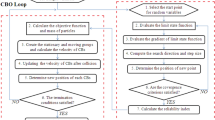Abstract
A general method is developed for optimal application of dampers and actuators by installing them at optimal location on seismic-resistant structures. The study includes development of a statistical criterion, formulation of a general optimization problem and establishment of a solution procedure. Numerical analysis of the seismic response in time-history of controlled structures is used to verify the proposed method for optimal device application and to demonstrate the effectiveness of seismic response control with optimal device location. This study shows that the proposed method for the optimal device application is simple and general, and that the optimally applied dampers and actuators are very efficient for seismic response reduction.
Similar content being viewed by others
References
Chang MIJ and Soong TT (1980) “Optimal Controller Placement in Modal Control of Complex Systems,” Journal of Mathematical Analysis and Applications, 75: 340–358.
Cheng FY and Jiang H (1998a) “Optimum Control of Hybrid System for Seismic Excitations with State Observer Technique,” Smart Materials and Structures, 7 (5): 654–663.
Cheng FY and Jiang H (1998b) “Hybrid Control of Seismic Structures with Optimal Placement of Control Devices,” ASCE Journal of Aerospace Engineering, 11 (2): 52–58.
Cheng FY, Zhang XZ and Lou ML (2003), “Seismic-resistant Structures with Soil-structure Interaction, Intelligent Active and Hybrid Control Systems,” Journal of Engineering Mechanics and Structure — International Journal, in press.
Cheng FY and Pantelides CP (1988), “Combining Structural Optimization and Structural Control,” NCEER Technical Report 88-0006, State University of New York at Buffalo, Buffalo, NY.
Goldberg DE (1989), Genetic Algorithms in Search, Optimization, and Machine Learning, Addison-Wesley Publishing Company, Inc., Reading, Massachusetts.
Hamdan AMA and Nayfeh AH (1989) “Measures of Modal Controllability and Observability for First- and Second-order Linear Systems,” AIAA Journal of Guidance, Control, and Dynamics, 12 (3): 421–428.
Kanai K (1957) “Semiempirical Formula for the Seismic Characteristics of the Ground,” Bulletin of Earthquake Research Institute, University of Tokyo, 35, 309–325.
Kobori T and Minai R (1960) “Condition for Active Seismic Response Control,” Transactions, Architectural Institute of Japan, 66: 253–256.
Lu J, Thorp JS, Aubert BH and Larson LB (1994), “Optimal Tendon Configuration of a Tendon Control System for a Flexible Structure,” AIAA Journal of Guidance, Control, and Dynamics, 17 (1): 161–169.
Milman MH and Chu CH (1994) “Optimization Methods for Passive Damper Placement and Tuning,” AIAA Journal of Guidance, Control, and Dynamics, 17 (4): 848–856.
Palazzo B and Petti L (1997) “Stochastic Rsponse Comparison between Base Isolated and Fixed-base Structures,” Earthquake Spectra, 13 (1): 77–96.
Rao SS, Pan T and Venkayya VB (1991) “Optimal Placement of Actuators in Actively Controlled Structures Using Generic Algorithms,” AIAA Journal, 29 (6): 942–943.
Soong TT (1990), Active Structural Control: Theory and Practice, Longman Scientific & Technical, United Kingdom and John Wiley & Sons Inc., New York.
Soong TT and Dargush GF (1997), Passive Energy Dissipation System in Structural Engineering, John Wiley & Sons, Chichester, England.
Tajimi H (1960), “A Statistical Method of Determining the Maximum Response of a Building Structure during an Earthquake,” Proceedings of the 2nd World Conference on Earthquake Engineering, Japan, 781–797.
Zhang XZ, Cheng FY, Jiang H, Chen GD and Lou ML (2002), “Hybrid Control Realization in Building Structures and Effectiveness Comparison with MR Control”, CD-ROM Proceedings of the 15th ASCE Engineering Mechanics Conference (Ed A.W. Smyth), New York.
Author information
Authors and Affiliations
Corresponding author
Rights and permissions
About this article
Cite this article
Cheng, F.Y., Jiang, H. & Zhang, X. Optimal placement of dampers and actuators based on stochastic approach. Earthq. Engin. Engin. Vib. 1, 237–249 (2002). https://doi.org/10.1007/s11803-002-0069-y
Issue Date:
DOI: https://doi.org/10.1007/s11803-002-0069-y



